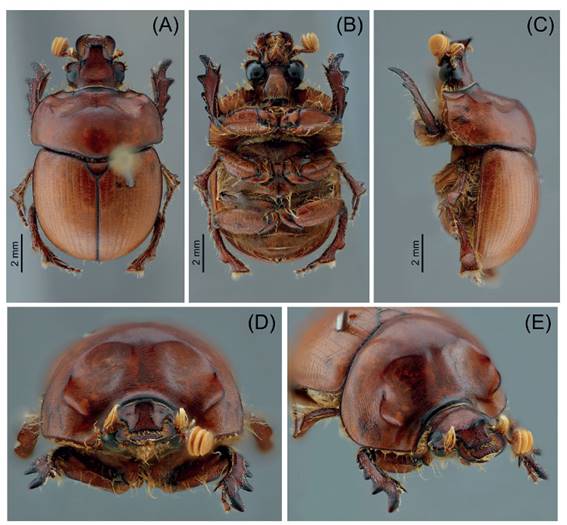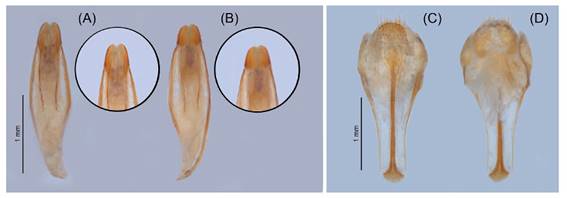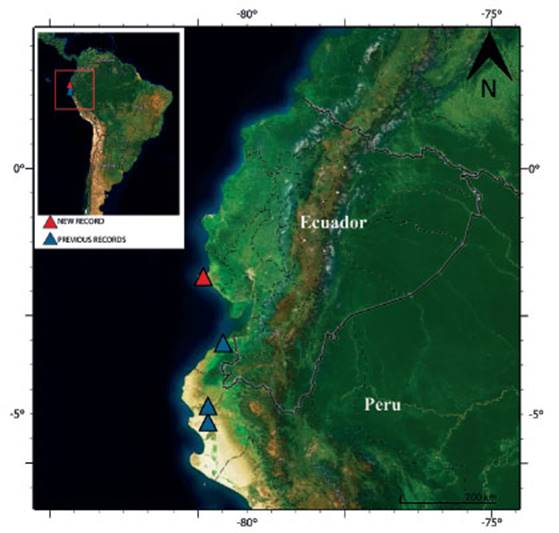Introduction
The subfamily Bolboceratinae belongs to the family Bolboceratidae, which was previously considered as a subfamily of Geotrupidae; however, Scholtz & Browne (1996) show the polyphyly between both taxa based on morphology and separated them as different families. Also, this fact has been partially demonstrated in recent molecular phylogenies of Coleoptera (e.g., Ahrens et al. 2014, McKenna et al. 2015, Neita-Moreno et al. 2019). Despite the morphological and molecular evidence, there is no consensus, and in recent works this group of beetles is listed as Geotrupidae: Bolboceratinae (e.g., Bouchard et al. 2011) or Bolboceratidae (e.g., Scholtz & Grebennikov 2016).
In South America, Bolboceratinae (Coleoptera: Bolboceratidae) is constituted by eight genera and 42 species (Martínez 1976, Ide & Martínez 1993, 1994; Mondaca & Smith 2008, Carvalho & Vaz-de-Mello 2022). Four South American bolboceratine species belong to the genus Zefevazia Martínez, 1954, which is mainly distributed in Argentina and Paraguay (Martínez 1976, Mondaca & Smith 2008); however, Zefevazia peruana (Boucomont, 1902) was described only for Peru and so far, is the northernmost record of this genus. Zefevazia was originally described by Martínez (1954), later, the same author considered it as a subgenus of Bolborhinum Boucomont, 1911 (Martínez 1976). Finally, Mondaca & Smith (2008) revised Bolborhinum and elevated the status of its two subgenera: Zefevazia and Pereirabolbus Martínez, 1976.
We present the first record of Zefevazia peruana (Boucomont, 1902) for Ecuador extending the record of this genus further into northern South America.
Material and methods
The single examined specimen is deposited at the Section of the Entomology and Biological Collections, of the Instituto de Investigación de Recursos Biológicos Alexander von Humboldt - IAvH-E, at Villa de Leyva, Boyacá, Colombia.
Specimen photos were taken with a camera Canon EOS 5d Mark III with a macro lens Canon EF 100 mm f/2.8; genitalia images were taken with a camera Leica MC190HD attached to a stereomicroscope Leica S8 APO. Distribution map was elaborated with Tableau Public 2021, ArcGIS Pro and Adobe Illustrator 2020, and is based on specimen label information and records in literature.
Results
Zefevazia Martínez, 1954
Zefevazia Martínez, 1954: 193. Type species: Zefevazia rosascostai Martínez, 1954 by original designation.
Diagnosis (sensu Mondaca & Smith 2008). Head in males with one frontal horn, females with one tubercle; antennal club semicircular. Pronotum in males with paired anteromedian excavations, which are marked basally by a transverse ridge; females with a small median concavity located behind the anterior margin of pronotal disc. Scutellum triangular. Elytron basally margined, with seven striae between medial suture and humeral swelling. Prosternal process reduced to absent. Metasternum pyriform, bulbous, with a long median carina; metasternal process wide, convex between mesocoxae. Mesocoxae distinctly separated. Male aedeagus subcylindrical, parameres short and subrectangular, truncated apically, apex wide.
Zefevazia peruana (Boucomont, 1902)
Bolboceras peruanus Boucomont, 1902: 185. Type locality: Grau, province de Thumbez, Pérou.
(Figs. 1‒3)

Figure 1 Zefevazia peruana (Boucomont, 1902), male from Ecuador. (A) Dorsal view. (B) Ventral view. (C) Lateral view. (D) Frontal view. (E) Frontal dorsal view.
Distribution. Peru (Boucomont 1902, Martínez 1976, Juárez-Noé & González-Coronado 2018), Ecuador (new country record ) (Fig. 3).
Material examined. ECUADOR, Santa Elena, La Libertad, Hotel Samarina, 02°13’S 80°52’W, 2 m, atraído por luz artificial, 01-31-xii.1997, Forero D. (1♂, IAvH-E-88458).
Records from literature. PERU: Piura [not specified which of the six localities sampled] (Juárez-Noé & González-Coronado 2018); Sullana, Hacienda Mallares (Martínez 1976); Tumbes, Grau (Boucomont 1902).
Diagnostic redescription . - Male (Figs. 1, 2). Length 13.6 mm. Color reddish-brown. Head with one cephalic vertical horn in the clypeal apex occupying the totality of the anterior edge; horn transversely compressed, with the apex truncated, slightly emarginated medially; anterior and posterior surface of cephalic horn coarsely punctate, near rugose, except at the very apex transversely smooth. Frons and vertex with sparsely small punctures. Labrum truncate, with lateral sides rounded, dorsal surface coarsely punctate, near rugose. Pronotum with two anteromedian excavations, space between excavations emarginate over the midline. Anteromedian pronotal excavations delimited over the external edge in the anterior half, by a vertical carina with two lobules, the anterior longer than the posterior; anterior lobe of the carina curved to the inner side. Anterior angles of pronotum excavated, excavations located right after the anteromedian excavations and the vertical carina, dorsally covered with minute punctures. Dorsal surface of the posterior half and the midline in the anterior half of pronotum covered with round fine punctures separated by one to two their diameter; lateral punctures of the posterior half, near the vertical carinae, coarser and bigger, somewhat coalescent. Punctures in the surface of the anteromedian excavations slightly smaller and transverse, with a strigulouse appearance. Scutellum triangular in shape, wider than long, surface with fine punctures. Elytron with 14 distinctly punctate striae, seven between median sutura and humeral swelling; punctures fine and separated by five times their diameter. Surface of interstriae sparsely covered with small punctures. Anterior tibiae with five teeth on the outer margin. Aedeagus and genital capsule as in Figure 2.

Figure 2 Zefevazia peruana (Boucomont, 1902), male terminalia. (A) Aedeagus, dorsal view. (B) Aedeagus, ventral view. (C) Genital capsule, dorsal view. (D) Genital capsule, ventral view.
Remarks. Zefevazia peruana was reported only from the Ecuadorian province of the Pacific dominion (sensu Morrone 2014, Morrone et al. 2022) (Fig. 3). The new record for Ecuador, also represents the northernmost record for the genus and species and the new record for the western Ecuador province, also in the Pacific dominion (Fig. 3). Furthermore, the species was reported in the Peruvian Department of Piura, in seasonally lowland dry forest (Juárez-Noé & González-Coronado 2018).
Despite that we were unable to study the female of the species, according to Martínez (1976), females of Z. peruana and its closely related species, Zefevazia cantisanii (Martínez, 1976), could be distinguished by the shape of the clypeal horn (robust in the later), the lateral carina delimiting each anteromedian excavation (obsolete in the later), and surface of the anterolateral excavations with punctuations (more evident and closely distributed in the later).
Discussion
Zefevazia peruana has been recorded in the departments of Piura and Tumbes in Peru, and in Santa Elena province in Ecuador. These territories correspond to the biogeographic Ecuadorian and Western Ecuador provinces, according to Morrone (2014) and Morrone et al. (2022). However, according with the biogeographical regionalisation of Udvardy (1975), correspond to the Ecuadorian Dry Forest province, which is the dominant vegetation type of the zone and the habitat in which the species has been collected (Juárez-Noé & González-Coronado 2018).
The other three species of Zefevazia are known from Argentina and Paraguay (Martínez 1976), therefore, Z. peruana is the northernmost species of the genus. Also, the new record from Ecuador now represents the northernmost record of the genus and species, which involve an extension of around 150 kilometers in straight line from the previous known closest record. Despite these data, the distribution of the species of Zefevazia are still poorly known and it is probable that important distribution extensions for all the species will occur in the future, as well as the possible discovery of new species.
Two genera of Bolboceratinae, each represented by one species, have been previously recorded from Ecuador: Bolbapium baeri (Boucomont, 1902) and Parabolbapium aequatoriensis Ide & Martínez, 1994 (Martínez 1976, Ide & Martínez 1994). The new record presented here raised to three the number of genera and species of the subfamily in the country. However, further detailed studies will show the composition and distribution of Bolboceratinae in Ecuador.












 uBio
uBio 



